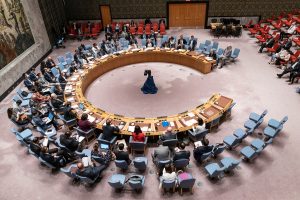
Today, September 21, is the International Day of Peace. The UN General Assembly has declared that this day is dedicated to “strengthening the ideals of peace, through observing 24 hours of non-violence and cease-fire.” Considering the global ambiance of violence currently prevailing around the world, nonviolence seems like a desirable goal. However, if we settle for not fighting, we will not prevent the next war, since peace means much more than a ceasefire.
Peace treaties last only as long as none of the parties are interested in violating them. Once a party sees an opportunity to gain through war, the treaty flies out the window.
When peace is broken, the animosity that caused the previous outbreak deepens, and the new round of violence becomes even more intense than its predecessor. In the end, the sides find themselves embroiled in an all-out struggle, a fight to the death. They will make peace only if neither side can destroy the other, and exhaustion and depletion of soldiers and arms force them to make “peace.”
Today, on the International Day of Peace, I would like to introduce the ancient meaning of the word peace, as it contains a more comprehensive solution, one that can outlast belligerent tendencies that are bound to resurface after the parties sign the treaty.
The Hebrew word for “peace” is shalom, from the word shlemut (“wholeness” or “complementarity”). By definition, “wholeness” or “complementarity” requires the presence of contradictions, since something can be whole only if all its elements and aspects are present. Likewise, complementarity requires the presence of contradictory elements that complement each other. After all, if one does not exist, what does the other complement?
We tend to think that only our view has merit and only our perspective should exist. However, reality is not built this way; it consists of opposites that complement each other, according to the definition of the word shalom. Could we imagine day without night, spring without fall, love without hate, or life without death?
Every coin has two sides: heads and tails. Eliminate the heads, and you have eliminated the tails, as well; eliminate the tails, and you have also eliminated the heads. Simply put, only when both sides of the coin exist can there be a coin at all. So is reality, eliminate one element in reality, and you have also eliminated its contradictory element.
Peace, therefore, can exist only when two parties maintain their opposing views and form a union without suppressing each other’s views. For example, every athlete knows that building strength requires the right balance between training and rest. Training and rest are contradictory, but only if both are present can the athlete become stronger.
Likewise, only people with conflicting views who strive to unite above their differences, without eliminating them, can form true and lasting peace, meaning wholeness. Their peace will last only as long as they maintain their attitude of complementarity and wholeness. If they revert to settling for nonviolence, they will soon be embroiled in war.
Today, when ceasefires are threatened or have already fallen apart, and the entire world is tilting toward war, learning how to build a strong and lasting peace is humanity’s single most important mission. I hope that countries will begin to think of peace as I have outlined it here, rather than settle for a pause in active fighting.
#peace #UnitedNations #nonviolence
Photo Caption:
UN Security Council meeting on maintenance of international peace and security at UN Headquarters in New York on August 22, 2022. Meeting was chaired by Chinese Ambassador Zhang Jun as China is holding the presidency of the Security Council for the month of August. Secretary-General Antonio Guterres delivered remarks and Gustavo Zlauvinen, President of the Tenth Review Conference of the Treaty on the Non-Proliferation of Nuclear Weapons also spoke on importance of reducing nuclear weapons, upholding non=proliferation of them and securing nuclear power plants in Ukraine which is experience invasion and military attacks by Russia. (Photo by Lev Radin/Sipa USA)
Posted on KabNet, Medium, The Times of Israel, Facebook, LinkedIn Newsletter